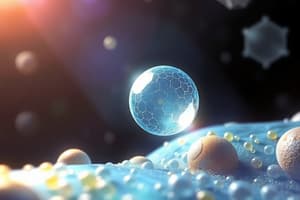Podcast
Questions and Answers
What role do channel proteins play in cellular membranes?
What role do channel proteins play in cellular membranes?
- They transport substances by changing shape.
- They control the flow of water only.
- They facilitate passive transport of all substances.
- They create a hydrophilic channel for certain molecules to pass through. (correct)
What is the function of aquaporins in cells?
What is the function of aquaporins in cells?
- To act as a barrier against lipid-soluble substances.
- To allow rapid passage of water molecules through the membrane. (correct)
- To transport glucose across the membrane.
- To transport ions selectively.
How do carrier proteins differ from channel proteins?
How do carrier proteins differ from channel proteins?
- Carrier proteins are only involved in active transport.
- Carrier proteins do not have specific molecules they transport.
- Carrier proteins change shape to shuttle substances across membranes. (correct)
- Carrier proteins allow all substances to pass freely.
What type of transport protein is so selective that it excludes fructose?
What type of transport protein is so selective that it excludes fructose?
Why is the role of transport proteins critical for hydrophilic substances?
Why is the role of transport proteins critical for hydrophilic substances?
What happens to the rate of glucose transport when using the specific carrier protein?
What happens to the rate of glucose transport when using the specific carrier protein?
What characteristic of transport proteins allows them to transport specific substances?
What characteristic of transport proteins allows them to transport specific substances?
What is the primary function of the hydrophilic channel in channel proteins?
What is the primary function of the hydrophilic channel in channel proteins?
What would likely occur without aquaporins in certain cells?
What would likely occur without aquaporins in certain cells?
What distinguishes a channel protein from a carrier protein?
What distinguishes a channel protein from a carrier protein?
Flashcards are hidden until you start studying
Study Notes
Cell Membrane Structure
- The plasma membrane separates living cells from their surroundings and regulates the movement of substances.
- Exhibits selective permeability, enabling cells to control chemical exchanges essential for life.
Composition of Cellular Membranes
- Comprised mainly of lipids and proteins, with carbohydrates also playing an important role.
- Phospholipids are the most abundant lipids, characterized as amphipathic (having a hydrophilic head and a hydrophobic tail).
- The arrangement of phospholipids forms a bilayer, creating a stable boundary between aqueous compartments.
Fluid Mosaic Model
- Describes the membrane as a fluid mosaic where molecules drift laterally.
- Cholesterol helps maintain membrane fluidity, with different effects at various temperatures.
- Fluidity is crucial for proper membrane function, permeability, and protein mobility.
Membrane Fluidity and Adaptations
- Membrane solidifies as temperature drops; specific lipid types influence solidification temperature.
- Organisms can adapt membrane lipid compositions for optimal fluidity under environmental changes.
- Examples of adaptations include:
- Fish in cold environments having more unsaturated lipids.
- Plants like winter wheat increasing unsaturated phospholipids in colder months.
Role of Membrane Carbohydrates
- Cell-cell recognition is essential for tissue and organ formation and immune responses.
- Carbohydrates on the membrane are often short, branched chains and can be attached to lipids (glycolipids) or proteins (glycoproteins).
- Variability in these carbohydrates allows for distinction among different cells.
Selective Permeability Mechanisms
- Lipid Bilayer Permeability: Nonpolar molecules (e.g., hydrocarbons, O2) can easily cross, while ions and polar molecules face barriers.
- Transport Proteins facilitate movement of specific ions and polar molecules:
- Channel proteins create hydrophilic passages for certain substances.
- Aquaporins greatly enhance water transport across membranes.
- Carrier proteins bind to specific substances and undergo shape changes to shuttle them across membranes.
Importance of Membrane Proteins in Medicine
- Proteins are crucial targets for many medications; for example:
- Omeprazole (Prilosec) blocks transport proteins that pump hydrogen ions, reducing heartburn.
- Fluoxetine (Prozac) inhibits serotonin re-uptake, affecting mood regulation.
Conclusion
- Membrane structure and dynamics are central to cell function, involving intricate interactions between lipids, proteins, and carbohydrates. Adjustments in composition and fluidity reflect evolutionary adaptations to diverse environments.
Studying That Suits You
Use AI to generate personalized quizzes and flashcards to suit your learning preferences.




